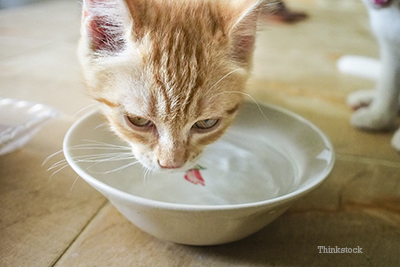
Do you notice a change in your cat’s water intake? The most obvious and common change is an increased intake of water called polydipsia. Animals, like people, typically drink for one reason — because they’re thirsty. On average, cats and dogs alike drink between 10-30 ml per pound per day. This amount can be impacted by the amount of moisture in the food, and water loss associated with exercise and panting. Remember that canned foods contain as much as 80% moisture.
All animals are a little different thus it is very important to know what is normal for your cat. However, in general, drinking more than 20 ml per pound per day is evidence of polydipsia, according to DVM360 Magazine.
So why would your cat begin to drink excessively?
There are 3 basic reasons for excess thirst:
- Compensatory
- Pathological
- Behavioral
Environmental causes may include excess heat, which results in panting as a natural cooling method, and leads to water loss that needs replacement. Vomiting and diarrhea also result in excess water loss that is generally compensated for by normally functioning kidneys. A diet change from canned to dry food, or to a dry ration with more salt, could result in increased thirst that really is appropriate.
Pathologic causes involve conditions that cause ongoing excess water loss. The body senses the problem and the response of excess thirst is an attempt to replenish the loss. Unlike environmental causes, pathologic water losses tend to be more ongoing. The most common causes of excessive water loss are:
- Kidney disease — in which the kidneys are unable to regulate fluid balance properly. They fail to reabsorb water and so excessive water is urinated away
- Diabetes mellitus — which is characterized by high levels of sugar (glucose) in the blood. As this glucose overflows into the urine it carries with it large volumes of water.
- Hormonal or endocrine diseases — such as primary (central) dibetes insipidus or renal (nephrogenic) diabetes insipidus. Both impact the ability of the kidneys to reabsorb water. In these two conditions the kidneys are not stimulated by or cannot respond to antidiuretic hormone (ADH) so fluids simply cannot be reabsorbed from the kidneys.
Behavioral causes of excess thirst are usually suspected when other conditions have been excluded. These are considered unusual in cats but have been linked to hyperthyroidism, which is quite common in older cats and can cause increased thirst for a variety of reasons.1
How is the cause of polydipsia determined?
Undoubtedly, your veterinarian will run blood and urine tests to evaluate the function of the kidneys and to check for diabetes, hyperthyroidism, and liver disease. A complete blood count is also likely to evaluate for anemia and infections. Specialized laboratory testing for other endocrine diseases and radiographs or ultrasonography may also be recommended.
What should I do if I think my cat is drinking too much water?
Because the mechanism of body fluid control is complicated, polydipsia is often associated with severe metabolic and systemic diseases. The sooner treatment and management of the underlying condition begins, the greater the likelihood of a positive outcome. So if you suspect that your cat is drinking excessively don’t delay, it is important to see your veterinarian as soon as possible.
If you have any questions or concerns, you should always visit or call your veterinarian -- they are your best resource to ensure the health and well-being of your pets.
References
1. Peterson ME, Kintzer PP, Cavanagh PG, et al. Feline hyperthyroidism: pretreatment clinical and laboratory evaluation of 131 cases. J Am Vet Med Assoc. 1983;183:103–110.
